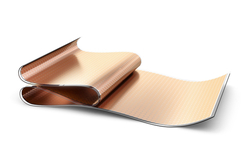Printed solar cell set to transform electronics manufacturing
The emerging field of organic electronics is already altering the way we use technology. From light emitting diode displays used in televisions, computers and mobile phones, to panels that convert sunlight into electricity, research institutes and companies are increasingly focusing on the potential of these applications. Enter SmartLine and CORNET, the EU-funded projects tackling the issue of manufacturing in this sector. As explained in an Organic Electronic Technologies (OET) press release, a research and development team supported by SmartLine has reported an efficiency of 7.4 % for a “fully Roll-to-Roll (R2R) printed polymer-based single junction Organic Photovoltaic (OPV) cell.” The team of ΟΕΤ, one of the partners in SmartLine, hopes to achieve 9 % efficiency in OPV cells by 2021. Quoted in the same press release, the company’s CEO says the “new result supports efforts for OPV panels mass production [of] up to 1.000.000 m2 annually, targeting various pilot demonstration projects in 2021.” Flexibility and cost efficiency Although OPVs aren’t currently as efficient at generating electricity as silicon-based solar cells, their performance has improved in recent years. The fact that they can be made rapidly on thin plastic sheets using established printing processes makes them attractive due to reduced manufacturing costs. It’s also possible to stick them to virtually any surface or object for a ready-made source of power. Therefore, the implementation of OPVs could be expanded into existing and new consumer products in a wide range of areas. These include “Energy, Lighting, Displays and Surfaces, Electronic Circuits, all (Bio) Sensors, Wearables, ICT [and] IoT,” according to the press release. However, the market acceptance of organic/large area electronics (OLAEs) is delayed due to several challenges, as summarised on the SmartLine project website. Some of these problems include insufficient control of the properties of materials and devices, low process yield, limited reliability and high consumption of resources, increased waste and high costs. To address these issues, SmartLine will provide practical industry solutions to achieve an improvement in OLAE devices production. The project website explains: “It will develop sophisticated non-destructive and robust in-line metrology and control solutions for R2R printing and OVPD [organic vapour phase deposition] processes for traceable measurement of properties and quality of highly integrated nano-layers and devices during their fabrication.” SmartLine (Smart in-line metrology and control for boosting the yield and quality of high-volume manufacturing of Organic Electronics) will digitise and transform the manufacturing processes also in other industries such as thin films (e.g. functional films, antimicrobial and decoration coatings, barriers), automotive, transport, space and health. Pooling resources Thanks to their promising future, OLAEs’ optimisation is also addressed by CORNET (Multiscale modelling and characterization to optimize the manufacturing processes of Organic Electronics materials and devices). It aims to develop a “unique EU Open Innovation Environment (OIE) covering the triangle of Manufacturing, Modelling and Experimentation,” according to the CORNET project website. To achieve this, the project will develop a sustainable OIE platform and OIE database. CORNET will link nanostructure features with macroscopic functionality through multiscale (nano to macro) characterisation and modelling. As a result, it will be possible to produce tailored OLAE devices and systems for demonstration in industrial applications such as automotive and greenhouses. For more information, please see: SmartLine project website CORNET project website
Countries
Greece



